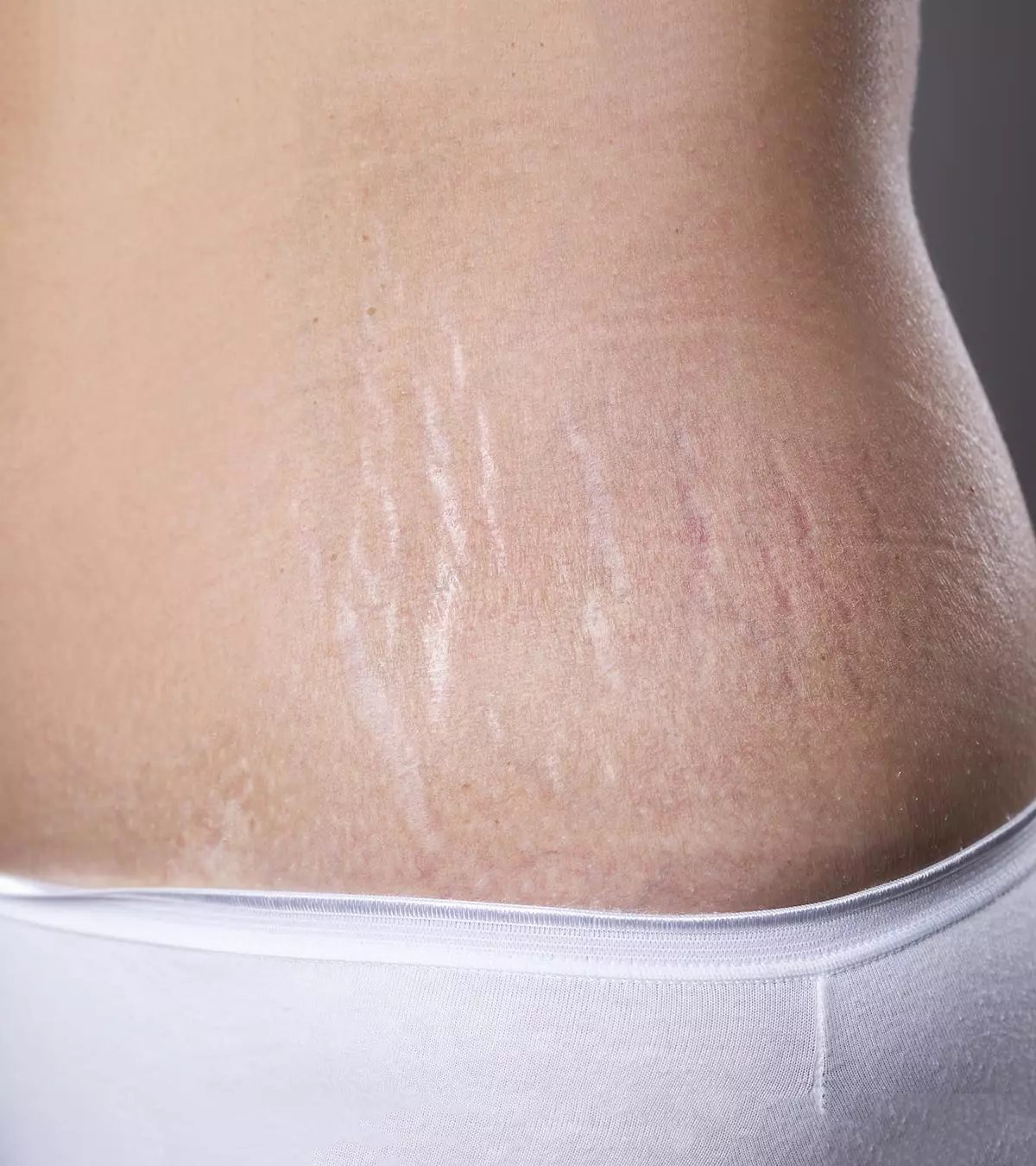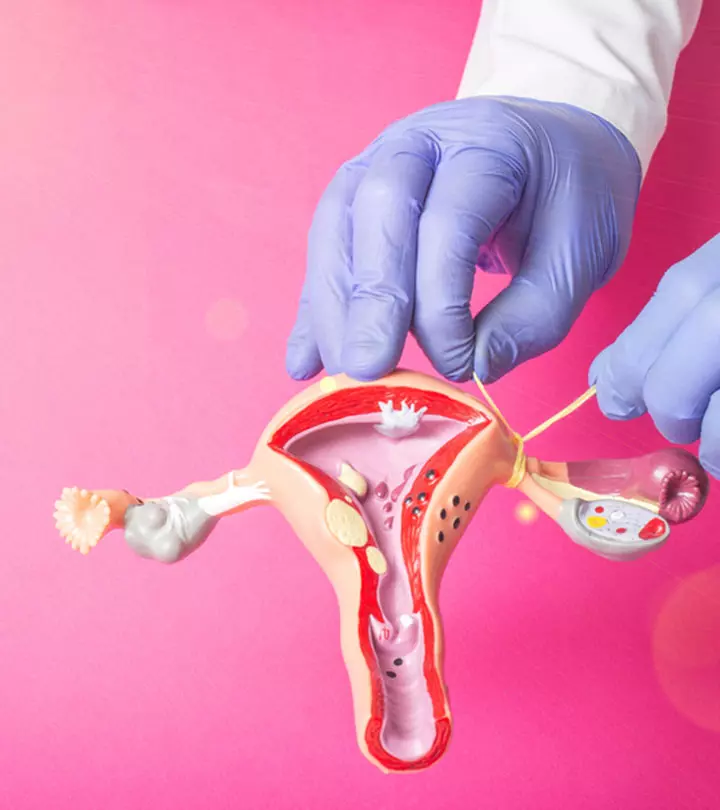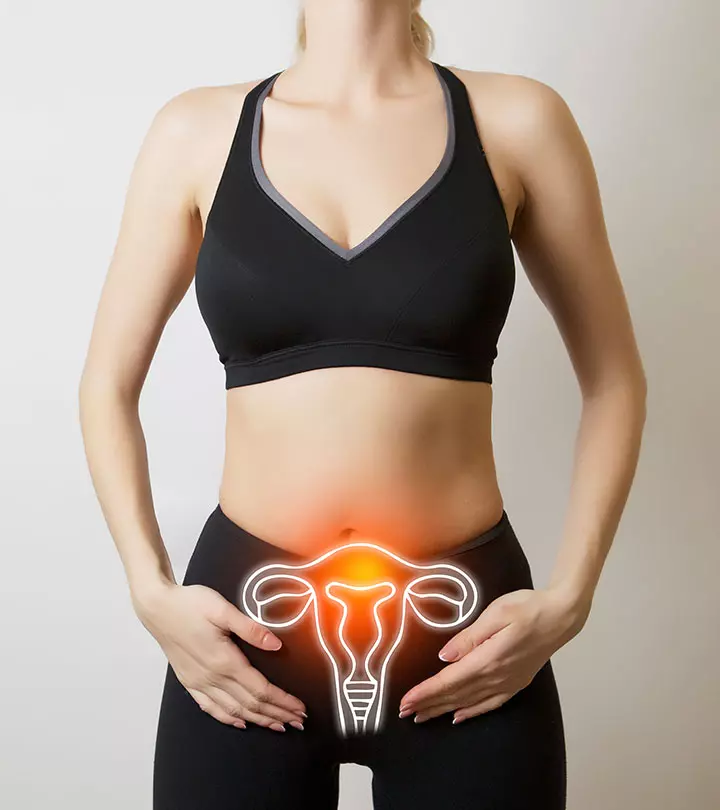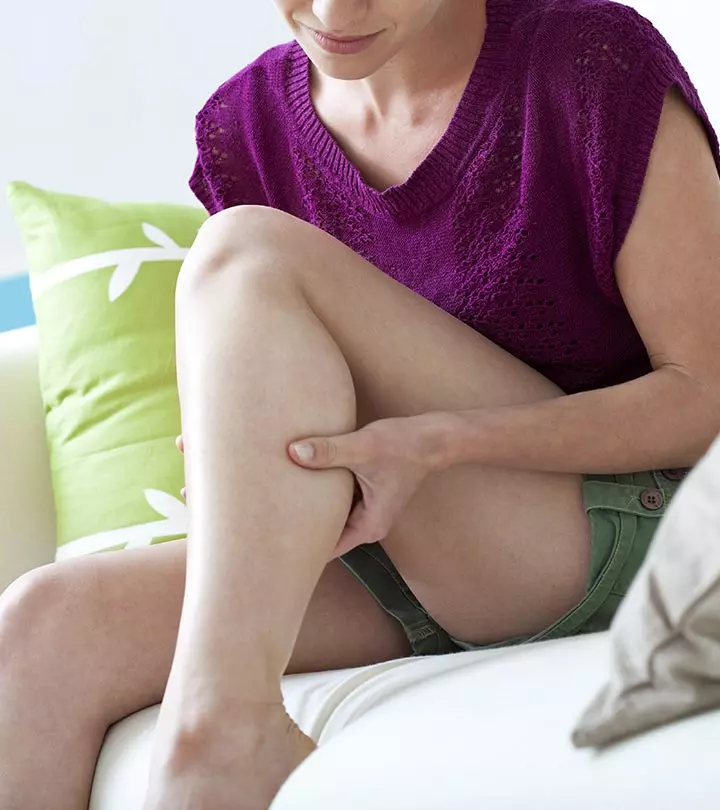
Image: ShutterStock
While some women accept their postpartum body, others may look for ways to tighten belly skin after pregnancy. It is natural for the skin around the belly to loosen after pregnancy and appear saggy. But it usually shrinks back to its normal state due to uterine contractioniPeriodic tightening of the uterus muscles during childbirth or menstruation that occurs from hormonal fluctuations. Although it may take some time, with these useful tips and efforts, you will start to notice the original shape of your stomach. In this post, we have shared some effective tips to help you get tightened belly skin post-pregnancy.
Key Pointers
- Eat a balanced diet with fruits, vegetables, lean protein, and healthy fats for healthy skin
- Exercise to build abdominal muscles and lose weight gradually
- Use relaxation and stress reduction techniques to keep your mind relaxed
- Belly size pre-pregnancy, weight gain, activity levels, bone structure, and genes affect time to tighten belly skin
Tips To Tighten Belly Skin After Pregnancy
The following ways might help in restoring and tightening loose stomach skin after pregnancy. However, they may not work the same way for all.
1. Eat healthy
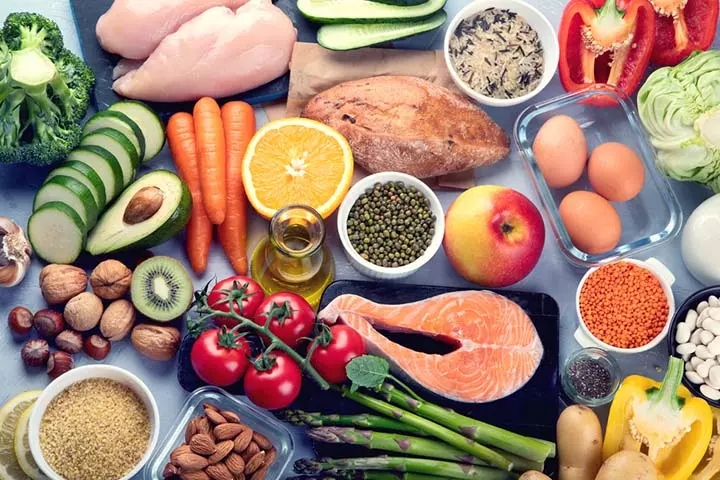
Your skin requires nutrients to maintain its elasticity. Therefore, you need to take enough nutrients for the skin to remain resilient and soft. Have a balanced diet of fruits, vegetables, lean protein, and fats to promote elasticity and the tightening of the loose skin (1). Consuming a healthy diet may also help in a few more ways:
- Fruits and vegetables such as broccoli, spinach, and strawberries, contain vitamins A and C. Vitamin A can help prevent drying of the skin (2) while vitamin C helps produce collageniA structural protein that helps build the connective tissue, skin, bones, and tendons and provides body flexibility that gives firmness to the skin (3).
- Almonds, sunflower seeds, and hazelnuts contain healthy fats. They also have vitamin E and antioxidants that help keep the skin healthy (4).
- Sweet limes, oranges, blackberries, strawberries, and raspberries promote collagen production that helps in tightening the skin. Vegetables such as lettuce, spinach, tomatoes, broccoli, carrots, beetroots, and bell pepper are also good sources of collagen.
- Zinc-rich foods, including pumpkin seeds, chickpeas, cashews, and mushrooms, also might help in tightening the skin (5).
- Protein-rich foods such as eggs, pulses, soy milk, sprouts, and quinoa may tone the muscles.
 Research finds
Research finds2. Exercise to lose weight gradually
Postnatal exercises are an excellent non-surgical option to help tighten saggy skin by strengthening the abdominal muscles. It helps you lose excess weight, tones stomach muscles and reshapes your body. Exercising also promotes circulation, which improves oxygen supply to the tissues and helps boost collagen and elastiniA protein found in the skin and other connective tissues that provides strength and elasticity to the body structures .
Your exercise regimen may include (6):
- Cardio exercises help tone the abdominal muscles by burning excess fat. For example, you may try brisk walking, jogging, bike riding, or swimming. But talk to your doctor about how soon you can start your tummy tuck exercises after your delivery.
- Strength training exercises strengthen and tone the muscles, which helps improve the skin’s elasticity and core strength. Cycling, crunches, and leg raises are some of them you may try.
Darian Healy, fitness instructor, and trainer, offers tips on selecting postpartum exercises. She advises choosing workouts that feel comfortable and enjoyable while supporting your postpartum lifestyle rather than adding stress (22).
Add variation to your exercise by either starting with cardio or strength training. Warm-up and stretch before you begin the workout. Try changing the exercise protocol every two weeks since you may get bored with the same workouts every day.
 Experts say
Experts say3. Practice breathing correctly

Before you participate in any exercise regimen or activity, correct your breathing rate. Breathe in deeply through your nose and let the air fill your lungs. Exhale slowly through the mouth to empty the lungs. The expansion and contraction of the belly through breathing may also work in tightening the loose skin.
Luca Williams, a blogger and mother, shares how a yoga technique helped her manage Diastasis Recti—a condition where the abdominal muscles separate, causing a bulge in the midsection, “I had Diastasis Recti, but I didn’t know it. I went to my NP, but she didn’t catch it, so I just kept thinking that I wasn’t doing enough exercise. Once I knew what was going on, I started to work with myself. The most important ‘exercise’ I did was a yoga move called Nauli- an abdominal and inner organ strengthener and toner. In just 5 minutes, my organs went home!!! My pooch was reduced in half (I have witnesses). I also started exhaling my air out of my mouth slowly while gently bringing my belly towards my spine (ii).
4. Keep a healthy mind
Do not lose your calm if you are unable to tighten your belly skin. It takes time, and you need a healthy mind to focus on it. Involve yourself in activities that will keep you happy.
- Practice deep breathing and meditation
- Listen to your favorite music
- Play with your little one
- Have some outdoor activities such as gardening
- Utilize the baby’s sleep time to take a nap. A research study states that new mothers who slept for less than five hours a night are less likely to lose their post-baby weight and have also gained extra weight (7).
Focusing on your emotional and mental well-being will contribute to physical wellness that is essential to work on the loose belly skin. But you will require patience to attain the results.
 Point to consider
Point to consider5. Drink sufficient water

Adequate hydration helps promote and maintain the skin’s elasticity (8). Keep drinking water regularly throughout the day (9). It reduces water retention and burns calories, which can make the loose skin less noticeable. Using a moisturizer also contributes to the skin’s ability to tighten skin.
6. Breastfeed your baby
Breastfeeding is helpful for both you and your baby. A few studies show that breastfeeding might help a new mother lose a few extra calories a day (10). Some studies indicate that breastfeeding may also aid in reducing waist circumference (WC) in the years following pregnancy, promoting long-term maternal health. However, the extent of weight loss differs for everyone and depends on other factors like diet, activity level, and metabolism (25).
7. Exfoliate your skin
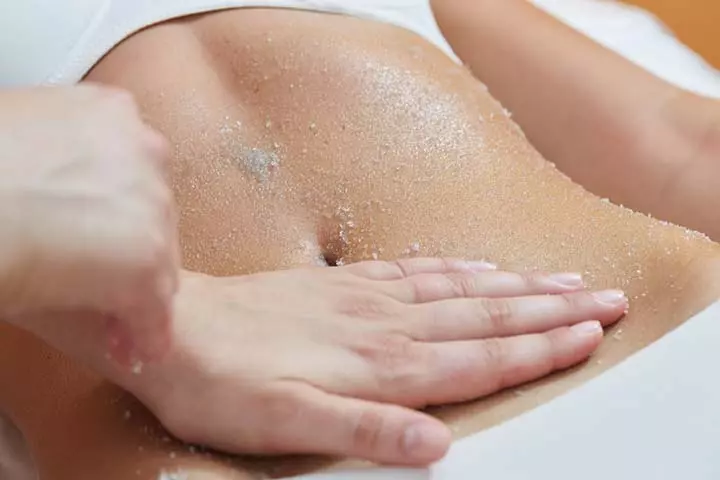
Exfoliation helps in removing dead cells and promotes new skin growth that will be healthier and tighter than the old skin. It is believed to improve the appearance of the skin. Use a loofahiA natural sponge used for exfoliating and cleansing the skin a sponge, or a bath brush to scrub your belly while taking a bath (11).
Some homemade exfoliating scrubs you may try:
- Combine one egg white with half a teaspoon of lemon juice and two tablespoons of sea salt. Mix well and massage onto your belly.
- Combine half a cup of oatmeal powder, two cups of sea salt and a few drops of olive oil and grape seed oil, and scrub on your belly.
 Quick tip
Quick tip8. Try belly wraps at spa
Getting a skin wrap at the spa may add firmness to the skin, but it is temporary. A spa wrap contains sea salt, powdered kelp, clay, algae, or nourishing oils. All of them detoxify the skin (12) and help in tightening it. However, ensure the ingredients are non-allergenic and safe for nursing women. If you’ve had a C-section, wait until you have fully healed before undergoing this treatment, and consult your doctor beforehand.
9. Go for a massage
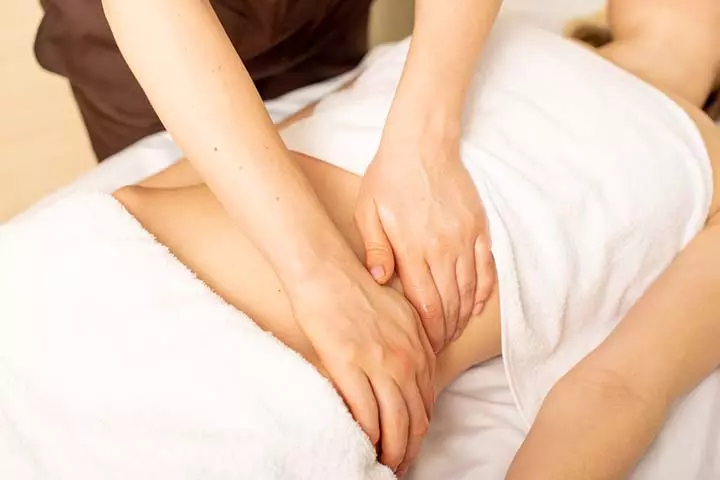
Getting an abdominal massage can promote blood circulation. However, check with your doctor before including it in your routine. You may use olive oil to rub the tummy line since the oil contains antioxidants (13).
Recalling her postpartum period, Nikki Sky, a mother, and entrepreneur, says, “Another thing that I did after getting out of the hospital and also up until the 6th week of 7th week postpartum mark was daily tummy massages. I cannot tell you how important it is to make sure that you massage that area really, really well. It gets all of the fluids out, helps with inflammation, and helps with muscle recovery (i).”
10. Try body wraps for skin tightening
Postpartum abdominal binding is a time-tested method to tighten the belly skin after pregnancy. It involves wearing a flexible and wide abdominal belt around the belly to compress the abdomen. These wraps provide support to the belly and back muscles and improve posture. They also help restore the shape of the uterus quickly and aid in the realignment of the organs in their pre-pregnancy positions.
Belly wraps have been proven to help with abdominal healing after a cesarean section by improving blood flow, decreasing pain, and supporting post-operative mobility. However, the binding should not be too tight to restrict your breathing or cause blood clots and injuries around your waist. In addition, you should also go for natural plant-based materials like cotton for the band and avoid wearing the band while sleeping for prolonged periods, especially at night (14) (15).
How Long Does It Take To Tighten Belly Skin?
The speed and degree of belly tightening after delivery depend on various factors. For some, it might just take a few months, while for others, it may take longer. A few factors influencing this transition include:
- The size of the belly before conception
- The weight gain during pregnancy
- Activity levels during pregnancy
- Maternal bone structure and body shape
- Genetics and age of the mother
- Skin elasticity and skincare routine
- Hydration levels and postpartum nutrition
- Multiple pregnancies
Depending on these factors, women may experience different postpartum recovery patterns, including belly tightening and weight reduction. Maintaining a healthy lifestyle with a balanced diet, adequate hydration, regular exercise, and proper skin care can help support and accelerate the process (7).
 Did you know?
Did you know?Frequently Asked Questions
1. Can stretched skin ever go back after pregnancy?
Stretched skin often develops broken elastic fibers, which may not return to their original state after pregnancy (16). However, as you progress in your postpartum recovery phase, the skin’s appearance may still improve, especially as you lose weight.
2. Which cream can tighten belly skin after pregnancy?
There are usually no specific firming creams to tighten the belly skin after pregnancy, and you may focus on keeping your skin hydrated. If you have severe stretch marks after pregnancy, your doctor may prescribe you tretinoin cream and other topical ointments (17).
3. What non-invasive procedures are used for tightening belly skin after pregnancy?
Non-invasive procedures, including ultrasound, radiofrequency therapy, and laser skin resurfacing, can help tighten skin after pregnancy. However, you can consider these procedures only after consulting with your doctor to avoid complications (18).
4. What about non-invasive procedures like ultrasound or radiofrequency therapy for tightening belly skin after pregnancy?
Non-invasive procedures may be used to tighten skin after pregnancy, but only after consulting with your doctor to avoid complications (18).
5. How effective are tummy tucks for tightening belly skin after pregnancy?
Tummy tucks can help get rid of the extra fat from the stomach and repair the separated abdominal muscles, but certain precautions must be followed. It is essential to ensure that one is at a stable weight before performing the procedure, and only a certain amount of the sagging skin can be removed with the help of the procedure. Thus, discuss your requirements and possible outcomes with the surgeon before proceeding (19).
Loosened belly skin normally shrinks back to its original size after pregnancy, but it takes time and effort. Following certain helpful advice, such as eating healthily, drinking enough water, and exercising regularly, will help you achieve tighter belly skin after pregnancy. Focus on nurturing your baby since breastfeeding can help burn extra calories, potentially helping you lose the post-baby weight and tightening the skin. If you are still unable to shrink your belly skin, do not be worried; remember that maintaining a good lifestyle and being healthy and happy is more vital.
Infographic: Tips To Tighten Belly Skin After Pregnancy
Loose skin is common after delivery as it will take time for your body to return to normal after childbirth. Also, your belly skin may not retain its pre-pregnancy appearance. Nevertheless, try the steps discussed in this infographic to tighten your loose abdominal area after delivery. Illustration: Momjunction Design Team

Illustration: Tips To Tighten Belly Skin After Pregnancy Without Surgery

Image: Dall·E/MomJunction Design Team
Personal Experience: Sources
MomJunction articles include first-hand experiences to provide you with better insights through real-life narratives. Here are the sources of personal accounts referenced in this article.
i. How I tightened loose skin post-pregnancy;https://www.youtube.com/watch?feature=shared&v=9_x97Up2jG0
ii. A scary word-Diastasis Recti-translation: belly sticking out after pregnancy;
https://movingwithgravity.wordpress.com/2015/11/19/a-scary-word-diastasis-recti-translation-belly-sticking-out-after-pregnancy/
References
Community Experiences
Join the conversation and become a part of our nurturing community! Share your stories, experiences, and insights to connect with fellow parents.
Read full bio of Dr. Saurabh Phadnis
Read full bio of Rebecca Malachi
Read full bio of Swati Patwal
Read full bio of Dr. Joyani Das










